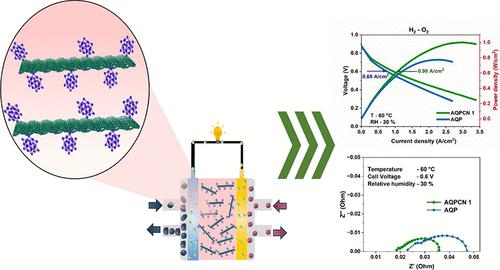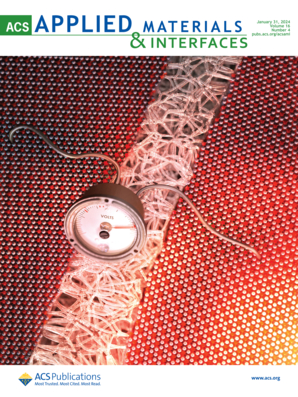Short-Side-Chain Membranes with Stabilized Superacid on Graphitic Carbon Nitride for Polymer Electrolyte Fuel Cells under Low-Humidity Conditions
IF 8.3
2区 材料科学
Q1 MATERIALS SCIENCE, MULTIDISCIPLINARY
引用次数: 0
Abstract
The integration of superacid-like heteropolyacids offers a promising route to develop highly proton-conducting membranes for energy storage and conversion. However, the inherent hydrophilicity of these acids can cause leaching, which undermines the fuel cell performance. In our research, we engineered a proton-conductive membrane with a facile hydrothermal synthesis approach to form stabilized hybrid superacids, namely, phosphotungstic acid (PTA), with graphitic carbon nitride (PCN) and its incorporation in a short-side-chain ionomer, namely, Aquivion. This unique approach via PCN nanohybrids enhances the proton transport within the membrane. These nanohybrids effectively combined the strong acidity of PTA with continuous 2D proton-transport pathways via a short side chain, resulting in a notable proton conductivity of 0.228 S cm–1 at 80 °C under 95% relative humidity. The real impact was evident in the performance of fuel cells using the Aquivion/PCN nanocomposite membrane, which demonstrated a significant improvement of 34% in the peak power density (1.0 W cm–2), and 44% cell performance (0.98 A cm–2) was retained for the nanocomposite membrane at a low relatively humidity (30% RH) at 0.6 V. This advancement represents a major leap in energy conversion and storage technologies at low-humidity conditions.

求助全文
约1分钟内获得全文
求助全文
来源期刊

ACS Applied Materials & Interfaces
工程技术-材料科学:综合
CiteScore
16.00
自引率
6.30%
发文量
4978
审稿时长
1.8 months
期刊介绍:
ACS Applied Materials & Interfaces is a leading interdisciplinary journal that brings together chemists, engineers, physicists, and biologists to explore the development and utilization of newly-discovered materials and interfacial processes for specific applications. Our journal has experienced remarkable growth since its establishment in 2009, both in terms of the number of articles published and the impact of the research showcased. We are proud to foster a truly global community, with the majority of published articles originating from outside the United States, reflecting the rapid growth of applied research worldwide.
 求助内容:
求助内容: 应助结果提醒方式:
应助结果提醒方式:


